
by Samantha Kennedy | Nov 15, 2024
Maintaining a healthy diet can be challenging, especially for individuals managing high blood sugar levels. Choosing the right snacks is crucial for avoiding blood sugar spikes and keeping energy levels stable throughout the day. Here, we explore several healthy snack options that are both delicious and beneficial for those with high blood sugar.
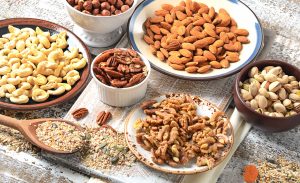
Snacks high in protein, fiber, and healthy fats such as nuts and seeds are a healthy choice for people looking to manage their high blood sugar. (Source: Adobe Stock photo)
Nuts and seeds. These foods are excellent snacks for people with high blood sugar. Almonds, walnuts, flaxseeds, and chia seeds are rich in fiber, healthy fats, and protein, which help stabilize blood sugar levels. A handful of almonds or a tablespoon of chia seeds in a smoothie can keep you feeling full and satisfied without causing a spike in blood sugar. Additionally, these snacks are packed with vitamins and minerals that contribute to overall health.
Fresh vegetables. Foods like carrots, celery, and bell peppers are low in calories and carbohydrates, making them ideal for blood sugar management. These veggies are high in fiber and water content, which help in maintaining a feeling of fullness. Pairing them with hummus or a Greek yogurt dip adds protein and flavor, creating a balanced and tasty snack option.
Berries. Foods such as strawberries, blueberries, and raspberries are not only delicious but also have a low glycemic index, meaning they do not cause significant spikes in blood sugar. Rich in antioxidants, vitamins, and fiber, a small bowl of mixed berries can be a satisfying snack. For added protein, consider combining them with a small portion of Greek yogurt or cottage cheese.
Whole-grain crackers and avocado. This combination provides a perfect balance of complex carbohydrates, healthy fats, and fiber. Whole grains help slow digestion, preventing sudden increases in blood sugar levels, while avocados offer monounsaturated fats that are heart-healthy and satisfying. Sprinkle some chia or sesame seeds on top for an extra nutritional boost.
Greek yogurt. This very versatile snack is high in protein and lower in sugar compared to regular yogurt. It is an excellent option for people with high blood sugar, as protein can help slow the absorption of carbohydrates, thereby preventing spikes. For a more filling snack, add a handful of nuts or fresh berries to a cup of Greek yogurt.
Hard-boiled eggs. This is a simple and convenient snack option packed with high-quality protein and healthy fats. They can help stabilize blood sugar levels and keep hunger at bay. Sprinkle a little salt and pepper or enjoy them with a side of fresh veggies for a complete snack.
Edamame. Also known as steamed soybeans, these are an excellent snack choice for those managing high blood sugar. They are high in protein, fiber, and essential vitamins and minerals. A half-cup serving of edamame provides a satisfying and nutritious snack that supports blood sugar control.
For individuals with high blood sugar, mindful snacking is essential to maintaining stable glucose levels and overall health. By choosing nutrient-dense, low-glycemic snacks such as nuts, fresh vegetables, berries, whole grains, Greek yogurt, hard-boiled eggs, and edamame, it is possible to enjoy delicious and satisfying snacks without compromising blood sugar control. Incorporating these healthy options into your daily routine can make a significant difference in managing high blood sugar effectively.
For more information about healthy eating for people with or without high blood sugar, please contact Samantha Kennedy, County Extension Director, at 850.926.3931.
An Equal Opportunity Institution.

by Claire Davis | Aug 2, 2022
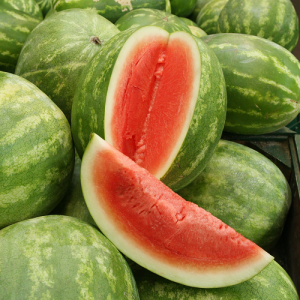 As summer is coming to a close and the kids are going back to school, National Watermelon Day is upon us! We have celebrated all of July as National Watermelon Month, but there is an extra day just for this sweet, juicy treat. This August 3rd, enjoy a slice, cube, ball, or spear of watermelon to celebrate National Watermelon Day!
As summer is coming to a close and the kids are going back to school, National Watermelon Day is upon us! We have celebrated all of July as National Watermelon Month, but there is an extra day just for this sweet, juicy treat. This August 3rd, enjoy a slice, cube, ball, or spear of watermelon to celebrate National Watermelon Day!
With the name watermelon, you could assume that the fruit is made up of mostly water. “How much water?” you may ask. 92 percent of the fruit is water! This is a great source of water for individuals who do not like drinking water, like myself. Another benefit is that since the water content is high, it helps individuals feel full. The combination of water and small amounts of fiber in this fruit helps you feel full without all of the calories. Watermelon is also beneficial in terms of digestion. Water helps the digestive tract to continue moving while fiber provides substance for your stool. This combination promotes normal, healthy bowel movements.
Not only is watermelon a great source of water for hydration, but it also has a lot of nutritional benefits. Fewer calories and no fat mean less guilt when eating the delicious fruit. There are approximately 47 calories per cup of watermelon. Watermelon also provides vitamins such as A, B1, B5, B6, and C. It also offers magnesium and potassium, both important factors in your daily intake. Vitamins A and C are critical components of healthy skin, as they assist with the production and repair of skin cells. Skin tends to look dry and flaky when you do not have enough intake of these vitamins. Vitamin C helps create collagen. Collagen keeps hair strong and skin elastic.
Now that you know why watermelon is an excellent fruit to consume, how should you celebrate it on its national day? Eating the watermelon by itself, as is, is a great place to start! If you are feeling adventurous, try making a fruit salad, adding salt or sugar, or throwing it on the grill. Check out one of my favorite recipes below for watermelon ice pops!
Tools needed: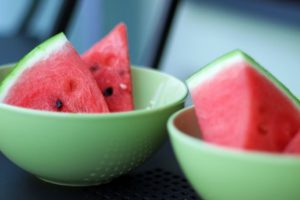
Ingredients (Yields 6):
- 1 ½ cups watermelon, seeded and diced
- ½ cup water
- 1 Tablespoon honey
- 1 Tablespoon fresh lemon juice
- 1 Tablespoon white sugar
Directions:
- Step 1: Blend all ingredients together in a blender until smooth.
- Step 2: Pour mixture into ice pop molds.
- Step 3: Place into freezer and freeze until solid. This takes about 2 hours.
- Step 4: Run water over the ice pop mold for a few seconds to help release the popsicle and enjoy!
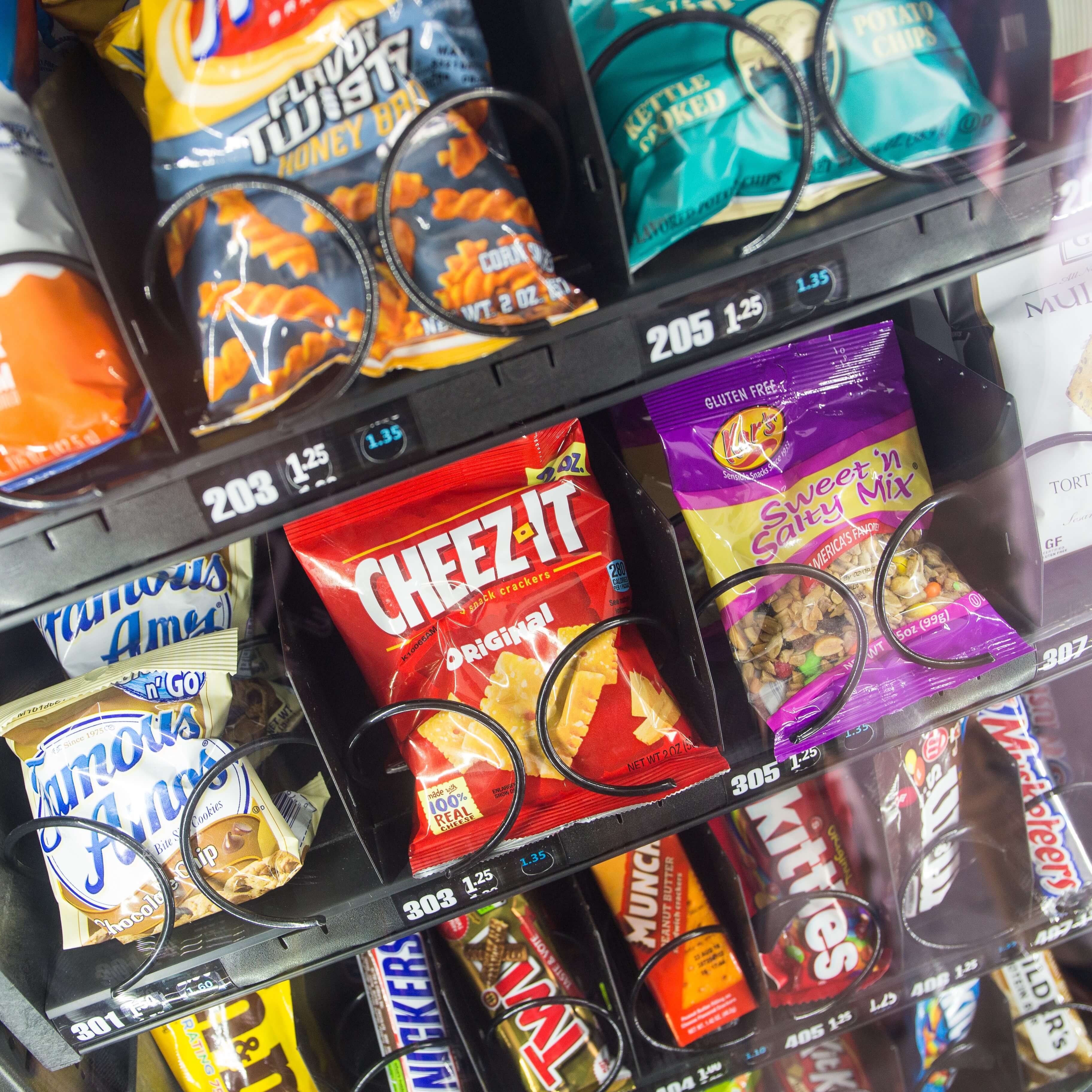
by Samantha Kennedy | Jan 26, 2018
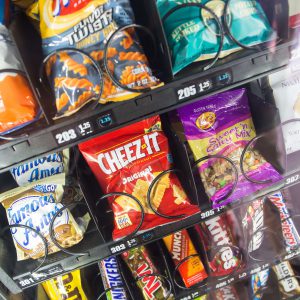
Convenient prepackaged snacks such as these can add extra salt, fat, and sugar to your diet. (Photo credit: Lyon Duong, UF/IFAS)
Snacks are an important part of a healthy, balanced diet. But not all snacks are created equal. All too often, we reach for the salty, sugary, prepackaged snacks like chips, cookies, and other sweets because they’re convenient and easy to grab and go. But be careful! Even if the portion size is small, these types of snacks can contain a lot of unnecessary calories. Even snacks marketed as healthy, such as trail mix, granola bars, and protein bars can contain added sugars and fats.
The Nutrition Facts label contains a wealth of information…if you know what you’re looking for. The number of total calories and calories from fat are listed at the top of the label. Ideally, snacks should contain less than 200 calories. Also, if the number of calories from fat is greater than 30 percent of the total calories, it may not be the best choice.
One of the biggest pitfalls when it comes to snacking is overeating. Snacks are meant to provide sustained energy to help keep blood sugar levels even throughout the day and to supplement calories and nutrients not provided by meals. They are not meant to be mini meals, so be careful of portion size. Check the label for what constitutes one serving and stick to it.
Prepare your own snacks instead of buying prepackaged convenience foods. Cut up fruits and vegetables and store them in snack bags that can be easily toted in your purse or bag. Keep small containers of nuts – preferably unsalted or lightly salted – in your desk or car for a high-protein on-the-go snack.
There are plenty of easy, delicious, and healthy snack choices from each food group. Here are a few examples:
Fruits: Bananas, melon chunks, apple slices, and orange wedges
Vegetables: Broccoli florets, carrot sticks, sugar snap peas, and zucchini sticks
Grains: Mini rice cakes, whole grain crackers, plain popcorn, and unsalted pretzels
Proteins: Nuts (e.g. walnuts, almonds, and pistachios), hard-boiled eggs, peanut butter, and pumpkin seeds
Dairy: Low-fat yogurt, string cheese, milk, and cottage cheese
Need more help with snacking healthy? Here are some terrific resources from the University of Florida IFAS:
“Healthy Eating: Sixteen Savory Snacks” – https://edis.ifas.ufl.edu/pdffiles/FY/FY70500.pdf
“Healthy Eating: Smart Snacking” – http://edis.ifas.ufl.edu/pdffiles/FY/FY70800.pdf
“Healthy Snacking” – http://edis.ifas.ufl.edu/pdffiles/FM/FM43900.pdf
“Raising Healthy Children: Promoting a Positive Feeding Experience” – http://edis.ifas.ufl.edu/pdffiles/FY/FY139700.pdf
by Amy Mullins, PhD, RDN | May 28, 2015
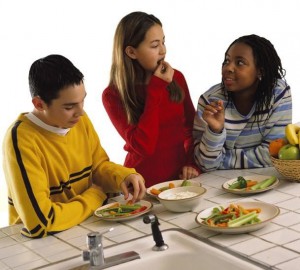
Super Summer Snacking
Can you believe that the kids are almost out of school for the summer? With kids in the house all summer, get ready for those constant snack attacks, followed by “mom (or dad)…there’s nothing good to eat.”
Just because its summer break doesn’t mean we should take a vacation from healthy eating. Having easy and nutritious snacks on hand is important for keeping those growing appetites in check.
ChooseMyPlate.gov recommends using snacks to help children get the nutrients they need to grow and maintain a healthy weight, but to limit sweets and sugary beverages to reduce excess calories that could lead to an unhealthy weight.
Follow these great ideas for snacks that are sure to please this summer:
- Save time by slicing veggies. Store veggies in the refrigerator and have tasty dips ready-to-go, such as hummus or low-fat dips (or even yogurt or peanut butter).
- Mix it up. For older kids, mix dried fruit with unsalted nuts and popcorn to make a great homemade trail mix. Also try blending low-fat yogurt with 100% fruit juice and frozen fruit for a refreshing and nutritious smoothie.
- Fruits are quick and easy. Fresh, frozen, dried, or canned fruits can be easy options that need little preparation.
- Nibble on lean protein. Choose foods such as low-sodium deli meats and cheeses, unsalted nuts, or eggs. Try pairing deli meat with apple wedges in a whole wheat tortilla wrap.
Check out Snack Tips for Parents at http://www.choosemyplate.gov/food-groups/downloads/TenTips/DGTipsheet24MyPlateSnackTipsforParents.pdf for more great ideas and the 10 Tips Nutrition Education Series from ChooseMyPlate.gov for tips on a wide variety of nutrition and healthy lifestyle topics.
Amy Mullins is a Registered Dietitian and Family and Consumer Sciences Agent II with UF/IFAS Leon County Extension. If you have additional questions about nutrition, contact Amy at mullinsa@leoncountyfl.gov.








